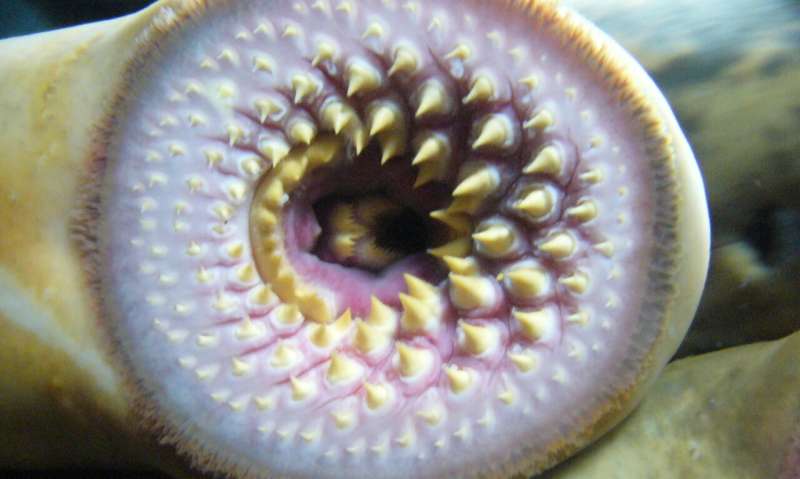Disease-causing protein in cystic fibrosis has ancient roots in sea lamprey

The oldest known ortholog of the ion channel that is defective in patients with cystic fibrosis arose approximately 450 million years ago in the sea lamprey, researchers report October 31st in the journal Developmental Cell. Many differences between lamprey and jawed vertebrate orthologs of this protein, called the cystic fibrosis transmembrane conductance regulator (CFTR), are vestiges of the evolutionary transition from a transporter to a specialized chloride and bicarbonate channel. Other differences likely reflect later adaptation of the sea lamprey to its specific environment.
"This study shows, for the first time, that CFTR existed with the basic function as an ion channel earlier than the ancient split between jawed and jawless vertebrates," says co-senior author Amit Gaggar of the University of Alabama at Birmingham. "This extends the existence of this gene through an additional 300 million years of evolutionary history. Importantly, these data provide a unique platform to enhance our understanding of vertebrate phylogeny over a critical period of evolutionary expansion."
CFTR belongs to an ancient class of transporters, called the ATP binding cassette (ABC) superfamily, whose members transport an array of substrates across membranes and play central roles in fundamental cellular functions. Rather than functioning as a transporter per se, CFTR serves as a chloride channel in epithelial cells lining various organs, including the lungs and intestines. "Out of the many thousands of ABC transporters identified, CFTR is the only one known to bear ion channel activity," says co-senior study author Nael McCarty of Emory University. "Understanding how channel function evolved from transporter function has been an enduring question in the field."
CFTR orthologs have been found in a variety of pre-mammalian organisms, including amphibians and bony fish. Until now, the oldest validated CFTR ortholog was that of the dogfish shark, which arose approximately 150 million years ago and retains similar structural and functional characteristics as the mammalian protein. "We reasoned that the identification of an earlier CFTR ortholog with altered structure or function would provide critical insight into the evolution of channel activity," Gaggar says. We therefore sought to trace the CFTR lineage back to the split between jawless vertebrates and jawed vertebrates and succeeded in cloning and characterizing the CFTR ortholog from the sea lamprey, a jawless vertebrate."
The researchers found that the lamprey CFTR (Lp-CFTR) diverges in sequence from all other known orthologs. For example, it contains the amino acid leucine instead of phenylalanine at the position equivalent to F508 in human CFTR, which is deleted in the majority of cystic fibrosis patients. "This result suggests that the leucine substitution is a lamprey-specific adaptation that may provide a specific advantage for survival in freshwater," McCarty says.
The functional properties of the channel are also different. Compared to the human ortholog, Lp-CFTR responds differently to compounds that inhibit or potentiate the protein. It also shows decreases in the rate of activation, open-state stability, conductance, and open duration. According to the authors, Lp-CFTR represents a significant departure from the relatively high amino acid identity and homology observed among CFTR orthologs from jawed vertebrates, suggesting the possibility of a function independent of anion transport—and more akin to ATP-dependent solute transport.
Compared to the lamprey kidney and gill, the intestine expressed the highest levels of CFTR. This result suggests that CFTR may have been differentially expressed in the gastrointestinal tract in the lamprey, but later in evolution it became expressed in other organs.
Overall, the study reveals an increase in the molecular complexity of CFTR from jawless to jawed vertebrates. "The lamprey ortholog provides a snapshot of the molecular evolution of CFTR. Key domains are intact, but the channel lacks several features that are fixed in all jawed vertebrate representatives," McCarty says.
According to the authors, the identification of Lp-CFTR provides a critical link between ancient ABC transporters and the human ortholog, which bears a more highly evolved function as a regulated chloride channel. "Although it is impossible to know what these selective pressures are, one major consideration is that the evolution from jawless fish to jawed vertebrates represented a tremendous expansion in genetic complexity in species," Gaggar says. "This complexity provides the need for effective and discrete cationic and anionic channels in organisms, although nature has come up with very few models for how to build proteins that accomplish this goal for anions."
In the end, research on this channel could have clinical implications for cystic fibrosis—the most common, fatal genetic disease in the United States. CFTR mutations in humans impair the removal of particles from the airways via the beating of hair-like structures called cilia, resulting in a buildup of thick, sticky mucus, bacterial colonization, airway inflammation, and potentially respiratory failure.
In future studies, the researchers will investigate the role of CFTR in the lamprey and use bioinformatics tools in combination with functional experiments to trace the path by which evolution led to improved channel function, from lamprey to human. In addition, they will study cell signalling pathways and small-molecule therapeutics that regulate CFTR, including those that are being developed as potential drugs for cystic fibrosis patients.
"Because mutant CFTR proteins expressed in patients represent broken channels, and their response to modulation by therapeutics is dependent upon regulation by cell signaling pathways, these studies will converge to provide important information for the further development of next-generation therapeutics for the diseases and conditions in which CFTR is involved," Gaggar says.
More information: Developmental Cell, Cui and Hong et al.: "An Ancient CFTR Ortholog Informs Molecular Evolution in ABC Transporters" www.cell.com/developmental-cel … 1534-5807(19)30773-7 , DOI: 10.1016/j.devcel.2019.09.017
Journal information: Developmental Cell
Provided by Cell Press



















